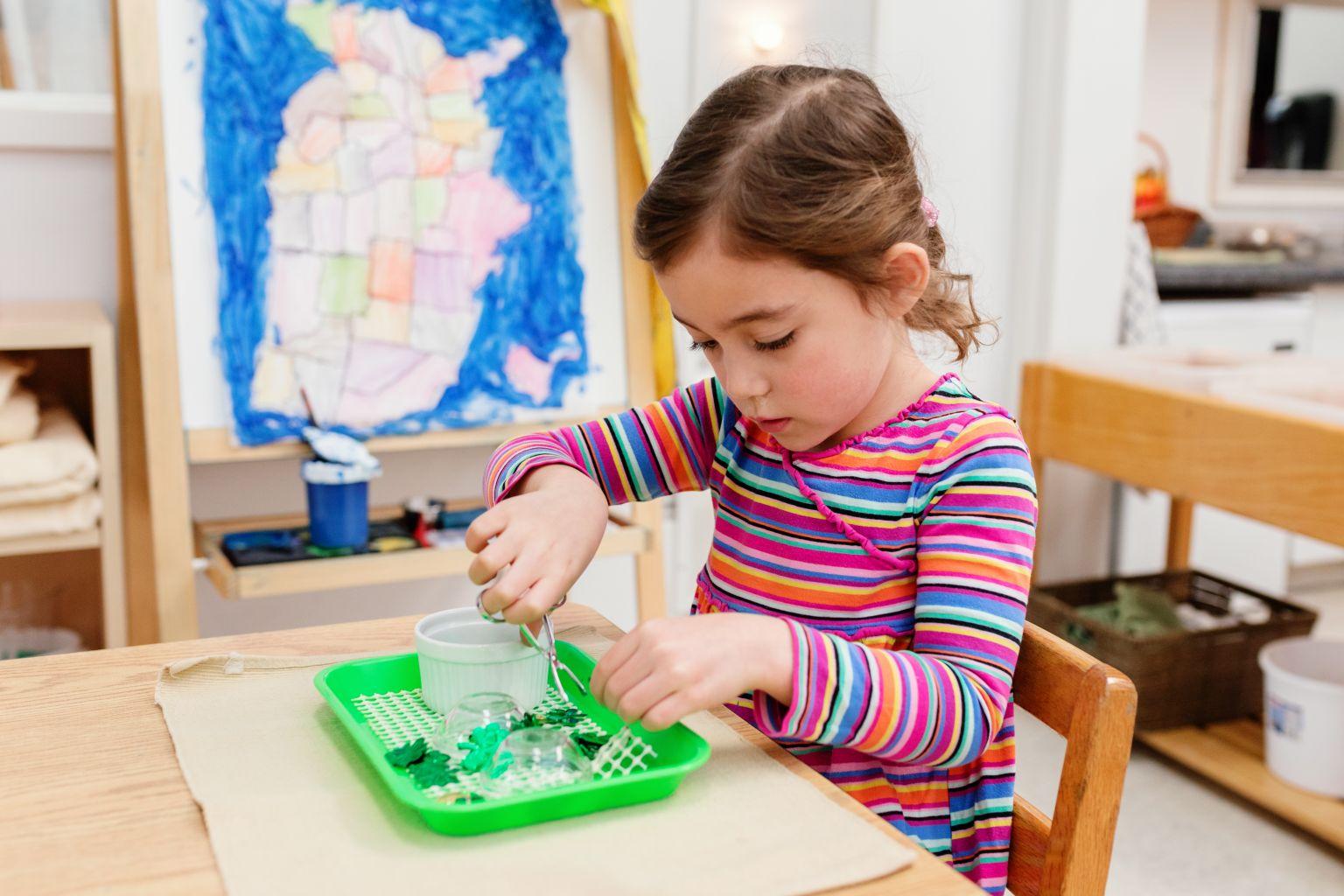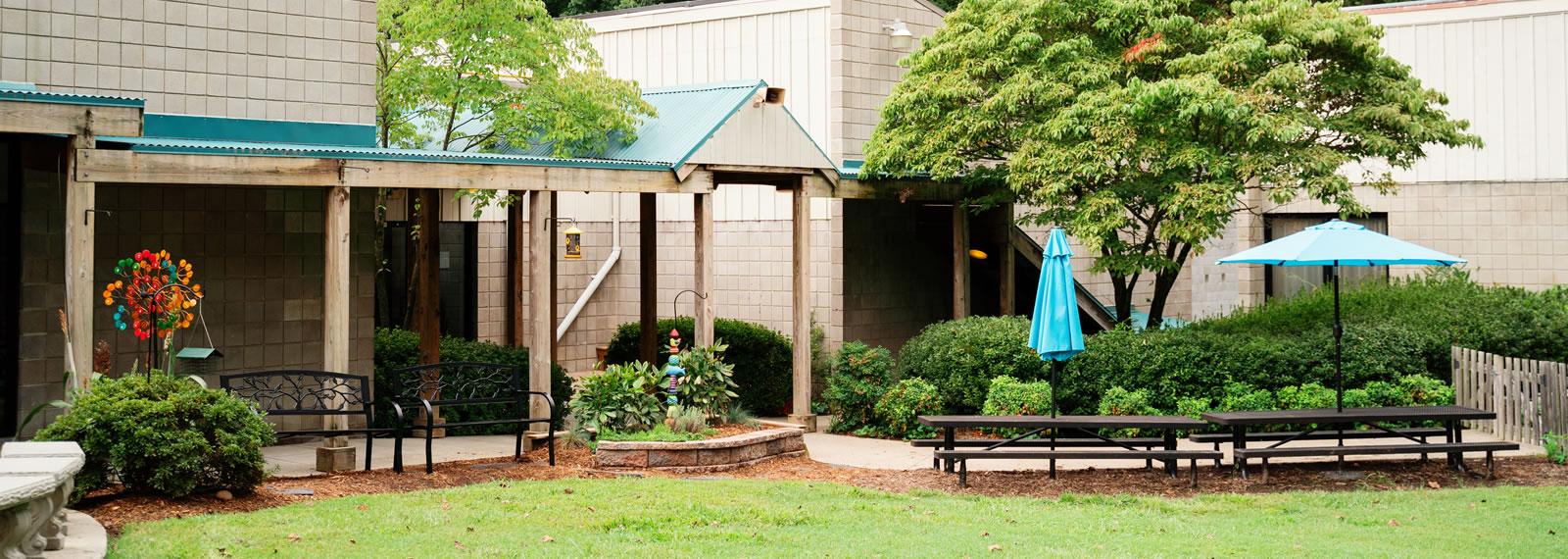Children learn best through exploring new concepts hands-on. Montessori schools encourage students to touch, feel, and do as they learn new ideas rather than just sitting at desks and listening to a teacher. As they move about the classroom, students can take part in the environment in a self-directed, explorative way, allowing them to take control of their learning experience.
Hands-on tasks are some of the most essential activities within a Montessori classroom. These activities allow students to use their hands to discover the world around them, keeping them captivated and focused on the subject at hand. A few examples of hands-on activities include pouring and scooping, washing the window, and gluing paper.
Pouring and Scooping
 If you have ever watched a child interact with a sand or water table, you know how much young ones love the concept of pouring and scooping. Pouring and scooping allow children to experience a new concept concretely. This activity can be applied to various subjects — math, gardening, counting, sorting, and more. Within these activities, teachers let students choose how to use the materials, giving them autonomy over their learning.
If you have ever watched a child interact with a sand or water table, you know how much young ones love the concept of pouring and scooping. Pouring and scooping allow children to experience a new concept concretely. This activity can be applied to various subjects — math, gardening, counting, sorting, and more. Within these activities, teachers let students choose how to use the materials, giving them autonomy over their learning.
Pouring and scooping activities help children develop fine motor skills at an early age. These tasks also provide valuable sensory experiences, which are vital to childhood development.
Washing the Window
Some of the most valuable Montessori tasks are ones that children can apply to their home lives. When students learn to wash the window — or any other practical chore — they can use their hands to engage the environment and practice new skills.
Washing the window can involve students using a spray bottle to distribute water across the surface, letting them practice using big arm movements and clamping the spray mechanism at the same time. These activities help children develop fine motor skills and teach them responsible ways to interact with family and home environments.
Gluing Paper
Gluing paper is another activity that can be applied to several different learning concepts. Teachers employ several types of gluing methods depending on the students' age groups and motor skills — some students may use popsicle sticks or Q-tips to apply glue to a page, while others may practice squeezing glue from the bottle.
Gluing activities help students develop fine motor skills and showcase their creativity.
Dressing Frames
Dressing frames are essential Montessori activities for independent learning and development. These materials help children learn to dress themselves: a vital activity in learning autonomy and self-sufficiency.
Dressing frames are essentially wooden towers consisting of three levels. These structures support 12 different "frames," three on each of their four sides, and include various materials and fasteners that children commonly see on clothing. A few standard dressing frames help children practice buttons, zippers, and buckles.
Button Frames
Button frames allow children to practice buttoning and unbuttoning cloth materials, an essential skill in learning to dress themselves. These frames may include large or small buttons, depending on the child's skill level.
Teachers guide the students to the buttoning frame and demonstrate how to button and unbutton the cloth, first by pinching the button in one hand and the material in the other.
Zipping Frames
Zipping frames help students learn to zip and unzip coats, shoes, pants, and other articles of clothing. Depending on the child's skill level, these frames may include zippers that cannot come detached, allowing students to practice the "up and down" zipping method.
More advanced frames help children learn to attach the zipper at the bottom of the frame.
Buckle Frames
Buckle frames give children the chance to practice buckling and unbuckling squeeze buckles, which they may find on a backpack or coat. Teachers demonstrate how to squeeze the sides of the buckle to release the insert piece from the external plastic. After watching the demonstration, students can practice the method on their own.
Puzzle Maps
Puzzle maps help children learn geography in a hands-on, engaging way. Many students struggle to visualize the world’s shape and layout, especially when they only see a.jpg) flat paper map. Puzzle maps allow students to understand the world’s shape and learn the placements of continents and countries in relation to one another.
flat paper map. Puzzle maps allow students to understand the world’s shape and learn the placements of continents and countries in relation to one another.
Map of the World
Younger students may start by exploring a puzzle map of the world. These wooden maps have uniquely colored pieces to represent each continent and showcase two perspectives of the globe, highlighting North America, South America, and Antarctica, and one that shows Africa, Europe, Asia, and Australia.
Puzzle maps of the word help students develop spatial awareness and an appreciation for the world’s layout. These maps help them understand the distance between continents and the size of the world overall.
Continent Maps
Once students have spent time engaging the Map of the World, teachers may introduce individual continent maps. These maps include pegged pieces to represent every country or island within a specific continent. Students can learn how to place each country within the continent — if each piece does not fit back together, the student has access to the natural control of error to guide them to the correct placement.
Gripping the pegs on puzzle maps also introduces children to how they will grip a pencil later on. Teachers will guide students to use the peg to maneuver each piece rather than grabbing it by its wooden sides, developing fine motor skills.
Classification Cards
Classification cards are Montessori activities that help children name and identify objects in their environment. Typically, each item comes with three classification cards: one with a picture of the object, one card with the object’s name, and one with the image and name together. Children learn to match the picture and name cards by comparing them to the control card.
Classification cards help children develop reading skills early and create an independent way for children to discover their environment. A few examples of classification card categories include animals and vegetables.
Animal Classification Cards
Many children love to identify animals and animal noises, and animal classification cards give them a method to explore new animals independently. These cards include pictures of various animals from across the globe, along with each animal's name.
Children can practice matching the animal's name to its picture, utilizing their linguistic and visual learning skills simultaneously.
Vegetable Cards
Vegetable classification cards help children learn and identify the names of various vegetables. These cards not only help with linguistic and visual learning, but they also encourage children to feel more comfortable with trying new foods.
When you introduce a new vegetable to the dinner table, your child can think back to the vegetable on their classification card, making the new food less unfamiliar.
The Montessori method utilizes a wide range of tried-and-true activities to promote independent, hands-on learning and discovery. Contact Richmond Montessori School today to learn more about our Montessori program or register for a Virtual Q&A Session.





